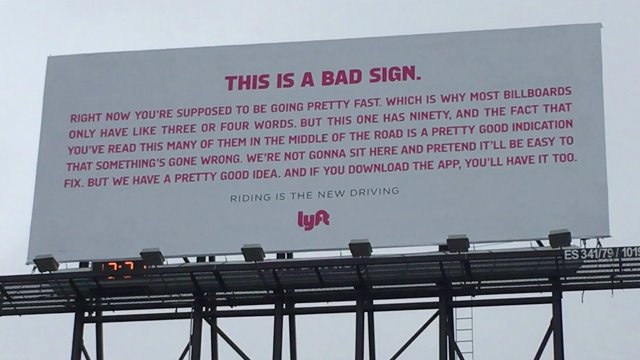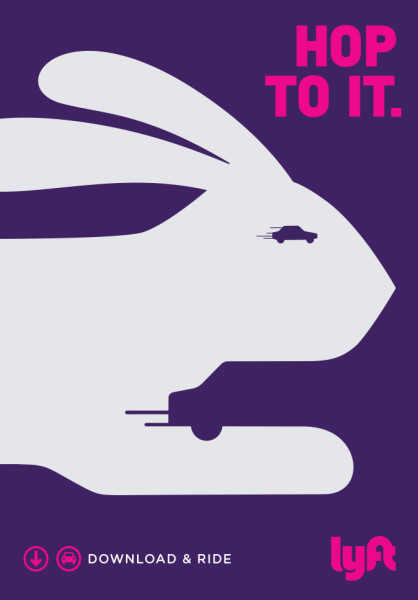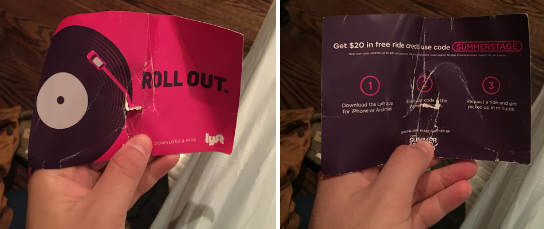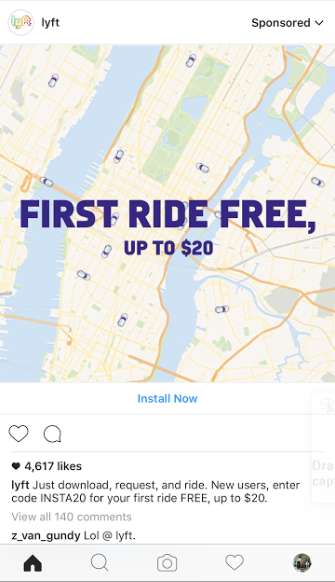A good marketing campaign makes the subject feel like they’re the only person being marketed to, and that’s exactly how I felt when I drove down to New York City last weekend to attend a concert in Central Park. Unbeknownst to me, driving from Boston to Sunset Park, riding the subway from Brooklyn to Manhattan, and walking throughout the Upper West Side exposed me to a relentless onslaught of targeted, strategic marketing from a service provider that I wound up really needed to use during my trip – Lyft.
If you’ve ever used PPC ads, you probably know how powerful targeting demographics like age, location and hobbies can be. And for plenty of companies making “awareness” ads for a wide audience, these simple filters work just fine. But for certain brands, the ROI from layering detailed, dynamic constraints on targeting can be well worth the time spent researching trends and analyzing data to get to know your audience.
Lyft took a creatively cohesive approach to corner me with traditional ads, as well as more personal digital marketing throughout my entire trip. And after just two nights, I converted. Looking back on my journey, I began to realize just how detailed of a look I gave them about my behavior, interests and patterns and how well they used that information to appeal to me.
Day 1: Laying the foundation
Lyft’s holistic approach to marketing their service to me began subtly: The groundwork involved setting up an infrastructure of traditional ads with goals as simple as getting me – a very stressed out-of-towner – to think about Lyft. Sitting in bumper-to-bumper traffic on the West Side Highway on my way to a friend’s place in Brooklyn, I looked up and saw this billboard.

I couldn’t help but imagine myself relaxing in the backseat of an air-conditioned Lyft while somebody else navigated the hot pink, mustached car through downtown 12th Avenue rush hour and negotiated around construction traffic in the Brooklyn-Battery Tunnel.
Working in conjunction with the billboards throughout the city, the cars themselves helped to promote the service as well. The glowing, colorful mustaches on the dashboards served as beacons to show me exactly every other car that I could have been chauffeured in. Instead, I was sweating behind the wheel of my own car, dodging pedestrians and rushing through yellow lights.
Upon arriving in Sunset Park, I walked out onto a pier to take the obligatory sunset picture of the Manhattan skyline. I proudly geotagged it as I posted it to social media. This is where I first, inadvertently, let Instagram know that I was traveling, and therefore, might potentially be more receptive to Lyft’s services.
Day 2: Laying it on thicker
On my second day in the city, I hopped on the R train up to the show in Central Park. I looked up and saw these lining the subway walls: After emerging from the subway and heading into the park, I consulted the concert’s Facebook event page to find the right entrance and double check what time the doors opened. I had already marked myself as “attending” on the event page, which was likely another action that helped Lyft segment me into their target lists. Snapping and tagging another photo on Instagram at the venue provided an up-to-date geotag of my whereabouts as well.
After emerging from the subway and heading into the park, I consulted the concert’s Facebook event page to find the right entrance and double check what time the doors opened. I had already marked myself as “attending” on the event page, which was likely another action that helped Lyft segment me into their target lists. Snapping and tagging another photo on Instagram at the venue provided an up-to-date geotag of my whereabouts as well.
When I arrived at the concert, I walked past a herd of idling Lyfts to enter the concert space. It was filled with banners sporting the Lyft logo, as well as booths with raffles and swag, and brand representatives offering ride discounts. When we were seated, the same Lyft reps came by and handed out flyers with promo codes, which eventually littered the ground at the venue.

Day 3: Desperate times call for last-minute rides
The show ended, and by midnight, I checked for subway directions on Google Maps before hopping on the 6 train to head downtown. This was my last broadcast of my personal information to advertising hosts that I was traveling in an unfamiliar city. I made it halfway back to my stop before the conductor announced the train was being taken out of service prematurely. While my friends figured out what train line to switch to, I pulled out my phone to mindlessly browse Instagram, and there it was, after about 30 seconds of scrolling through my feed:
 All the pieces were in place, and this was their big pitch, just when I needed it. From the awareness billboards on day one, to the tracking of my location, destination and event attendance on day two, Lyft’s campaign felt personal and patient. I downloaded the app when I saw the final ad, and we mustached our way home immediately. I was officially a customer.
All the pieces were in place, and this was their big pitch, just when I needed it. From the awareness billboards on day one, to the tracking of my location, destination and event attendance on day two, Lyft’s campaign felt personal and patient. I downloaded the app when I saw the final ad, and we mustached our way home immediately. I was officially a customer.
More to a targeted ad than age, hometown & gender: 8 dynamic data points to target
Lyft isn’t the only brand taking a long-term, studied approach to marketing to people’s needs and patterns, and while they used Instagram to make their final pitch to me, there are a variety of services and hosts you can leverage to reach your target audience most effectively. Whether you are in the B2C or B2B space, you can find opportunities to integrate each of the following targeting objectives into your digital marketing strategy.
1. Target people traveling
Target your audience’s travel patterns. Ad hosts like Facebook know that I live in Boston – I openly list it as my home. However, any time I log on from another city, check in at an airport, geotag a photo somewhere else or even mention “travel” in a status, they’ll infer that I’m out of town. I might expect to see mobile ads ranging from rideshares to local attractions to travel toothbrushes. Lyft recognized my traveling status, and knew there was potential to turn me into a customer.
2. Set up a smart radius
Focus on very specific areas. The more geographically detailed your marketing gets, the better your chances of reaching exactly who you want. Lyft might have found me by targeting an immediate radius around Central Park, within walking distance from high-traffic, often congested subway stops. You could do something similar for an upcoming tradeshow or surrounding your brick-and-mortar location, for instance.
3. Throw in a filter to appear for fans of your brand
Reach interested, receptive audiences by narrowing the targeting down to Facebook fans or event attendees. In my case, Lyft could have targeted me at this concert because I “like” the band on Facebook and marked myself as “attending” on the event. It’s almost a guaranteed way to reach a desired audience.
4. Take advantage of deep data mining: Mics, messages, searches, texts and other apps
Go deep. Google and other ad hosts are collecting huge amounts of user information, so get as specific and detailed as possible with how you target your campaign. There’s more than enough usable data within reach for you to reach qualified audiences.
5. Get creative with retargeting your audience
Segment your retargeting efforts between your current and prospective customers. You can even retarget based on app use. Lyft, for instance, could have displayed their ad to me because I checked out their website or because I have had the app installed on my phone in years past (even though I never signed up or used it for a ride).
6. Target the competition’s audience
Most ad hosts allow you to target users of competing websites and services. I am an avid user of Uber, reluctant rider of public transportation, and proud owner of a used car, and Lyft has access to that information (or at least data that suggests it). Spending money on reaching me with their offer is an effective way to pry me away from my normal modes of transportation, and onto theirs.
7. Make your ads time-sensitive
There’s more to timing an effective ad than choosing the right time zone and the best time of day. Plan your timing strategically: Marketing a rideshare at midnight on a Saturday near a club might be more effective than at 4 a.m. on Tuesday in the Financial District or 2 p.m. on Wednesday in the suburbs. Lyft reached me by timing their Instagram ad to display around the ending of the Kamasi Washington concert.

8. Target lookalikes
Once you have a clear idea of who you’d like to appeal to, some ad servers allow you to target users with similar interests and patterns as your original audience to increase your reach, while still keeping your message focused. Facebook’s Lookalike Audience option is a popular and simple way of targeting other interested audiences.
Don’t be afraid to get extremely specific when you target your audience through social, PPC and other online ads. Sure, the investment of time and cost per click might seem daunting, especially when your target audience sizes seem small. But it succeeded in converting me: I downloaded the app, used it right away and now keep it on page one of my phone. Coupled with strong content marketing strategies, a finely tuned and contextually targeted ad campaign is almost always worth the effort as long as it continues to drive conversions.



